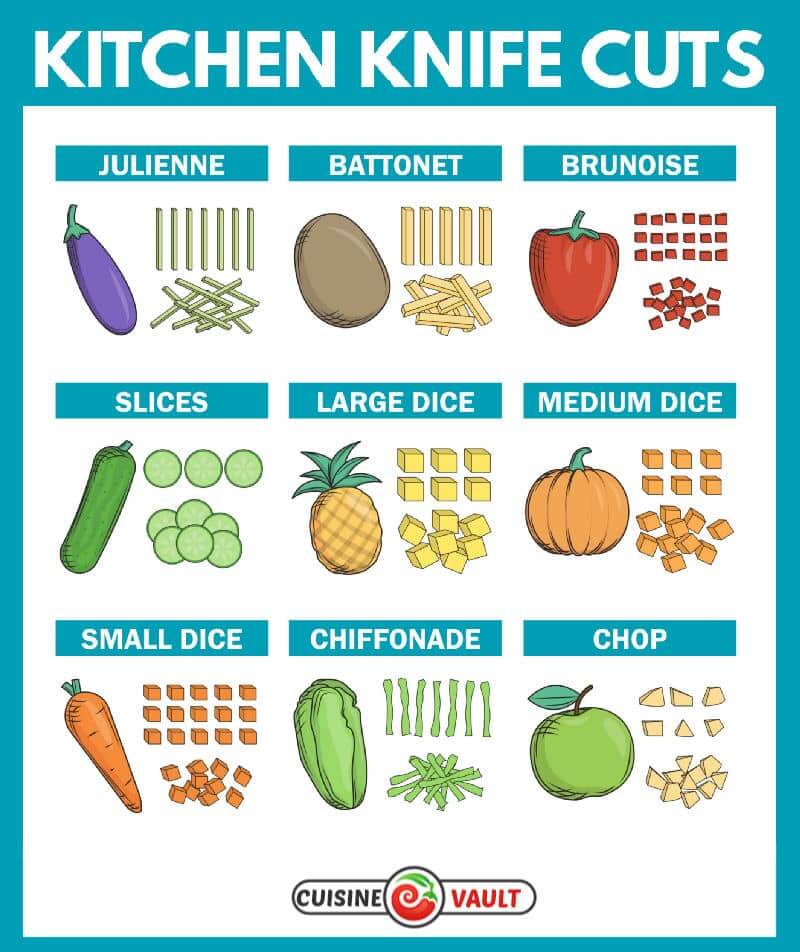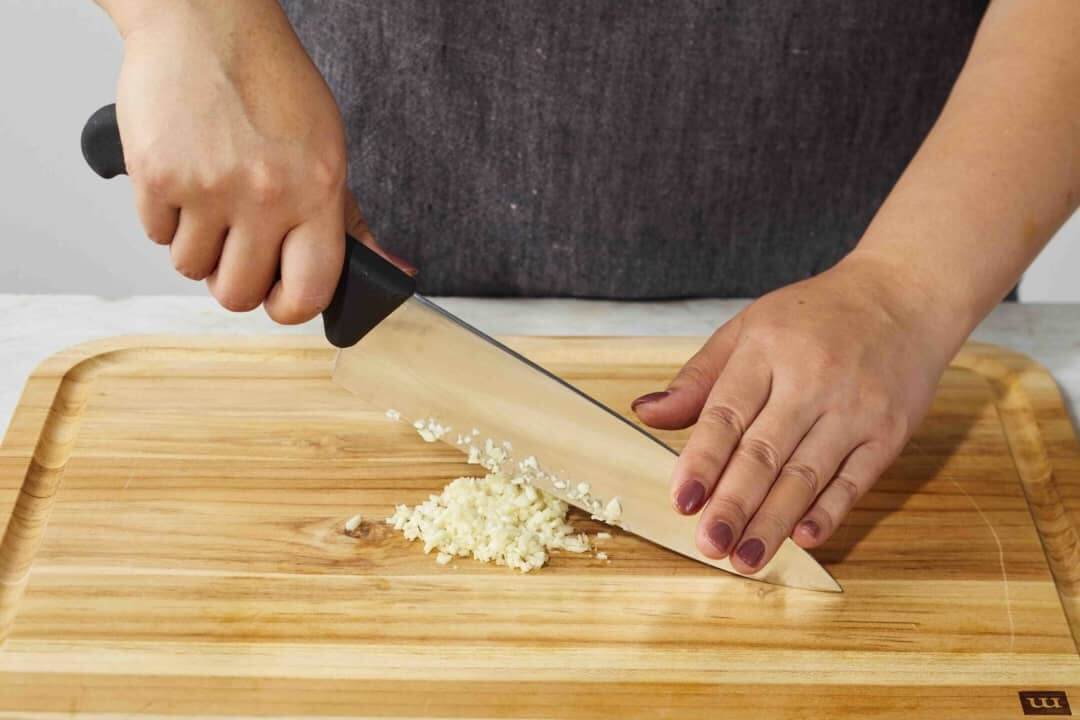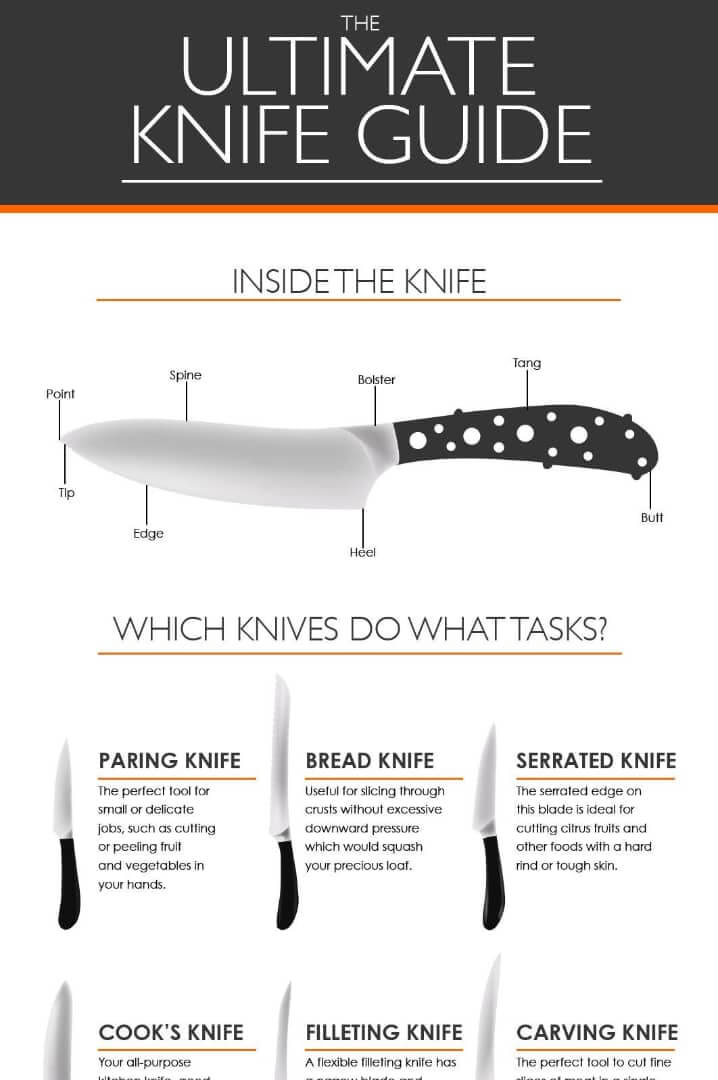Introduction
When it comes to cooking, mastering knife skills is like learning the alphabet—it’s the foundation of everything else. Whether you’re slicing vegetables for a hearty soup, mincing garlic for a fragrant stir-fry, or chopping herbs to finish a dish, knowing how to wield your knife efficiently and safely can elevate your cooking game. In this guide, we’ll explore the essential knife cuts every chef, from beginner to pro, should master. Let’s get chopping!

1. Julienne: The Classic Matchstick Cut
Description:
The Julienne cut produces thin, uniform strips about 2-3 inches long and ⅛ inch thick, resembling matchsticks.
Step-by-Step Instructions:
-
- Trim the ends of your vegetable (e.g., carrot, zucchini).
- Slice it into rectangular sections, about 2 inches long.
- Stack the sections and slice them into thin, even strips.
Applications:
Perfect for stir-fries, salads, and garnishes.
Pro Tip: Use a sharp knife to avoid crushing delicate vegetables like zucchini.
2. Brunoise: Tiny Cubes, Big Flavor
Description:
The Brunoise cut is a fine dice, creating small cubes about ⅛ inch on each side.
Step-by-Step Instructions:
- Start by cutting a vegetable into Julienne strips.
- Turn the strips 90 degrees and dice them into tiny, even cubes.
Applications:
Ideal for soups, sauces, and salsas where uniformity ensures even cooking.
Pro Tip: Use the Brunoise cut to impress your dinner guests with perfectly diced onions or carrots.
3. Chiffonade: Elegant Herb Ribbons
Description:
Chiffonade is a technique used to create thin ribbons of leafy herbs or greens.
Step-by-Step Instructions:
- Stack a few leaves (e.g., basil, spinach) neatly.
- Roll them tightly like a cigar.
- Slice the roll thinly to create elegant, uniform ribbons.
Applications:
Perfect for garnishing pasta, salads, or soups.
Pro Tip: A gentle grip helps prevent bruising delicate herbs.
4. Dice (Small, Medium, Large)
Description:
Dicing creates evenly sized cubes, ranging from small (¼ inch) to large (¾ inch).
Step-by-Step Instructions:
- Cut the vegetable into planks.
- Stack the planks and cut them into strips.
- Turn the strips 90 degrees and cut into cubes.
Applications:
Great for stews, salsas, and mixed vegetables.
Pro Tip: Consistent sizes ensure even cooking.
5. Mince: Tiny Pieces for Big Flavor
Description:
Mincing produces extremely fine pieces, often used for garlic, ginger, or shallots.
Step-by-Step Instructions:
- Peel the ingredient (e.g., garlic).
- Slice it thinly, then run your knife through it repeatedly in a rocking motion until finely minced.
Applications:
Perfect for sauces, marinades, and dressings.
Pro Tip: Sprinkle a little salt on garlic to keep it from sliding around while you mince.
6. Batonnet: Thick Matchsticks
Description:
Batonnet cuts are thicker than Julienne, measuring ¼ inch thick and 2-3 inches long.
Step-by-Step Instructions:
- Trim and square off your vegetable.
- Slice into planks, then into thick, uniform sticks.
Applications:
Great for crudité platters or as a starting point for larger dice cuts.
Pro Tip: Use Batonnet cuts for homemade French fries!
Knife Skills in Action: Real-World Applications
- Julienne: Use Julienne-cut carrots and bell peppers for a quick and colorful stir-fry.
- Brunoise: Diced onions and carrots are perfect for a creamy risotto or a hearty bolognese sauce.
- Chiffonade: Sprinkle basil ribbons over a Margherita pizza for a fresh finish.
- Mince: Add minced garlic to olive oil for a fragrant base to any pasta dish.

Knife Safety Tips to Keep in Mind
- Always Use a Stable Cutting Surface: Place a damp towel under your cutting board to prevent it from sliding while you work.
- Keep Your Knives Sharp: A dull knife requires more force and increases the chance of slipping. Sharp knives make clean cuts with less effort.
- Store Knives Properly: Use a knife block, magnetic strip, or protective sheath to prevent dulling and accidents.
- Avoid Cutting Towards Yourself: Always cut away from your body to reduce the risk of injury.
- Practice the “Claw Grip”: Tuck your fingers under and use your knuckles to guide the knife while slicing. This protects your fingertips and improves precision.
FAQs
- What’s the difference between Julienne and Batonnet? Julienne produces thinner, matchstick-like cuts (⅛ inch thick), while Batonnet results in thicker sticks (¼ inch thick). Both are great for different cooking techniques and presentations.
- How do I choose the right knife for each cut? A chef’s knife is versatile and can handle most cuts, but for more delicate tasks like Chiffonade, a paring knife may offer better control.
- How often should I sharpen my knives? Sharpen your knives every 2-4 months, depending on frequency of use. Hone them with a steel rod after every few uses to maintain the edge.

Practice Makes Perfect
Don’t be discouraged if your first attempts aren’t perfect—knife skills improve with practice. Start slow, focus on consistency, and soon you’ll be slicing and dicing like a pro!
Conclusion
Mastering these essential knife cuts is a game-changer in the kitchen. With a little practice, you’ll speed up your prep time, improve your presentation, and enhance your cooking skills. Ready to take your knife skills to the next level?
Download our free Knife Skills Cheat Sheet and start practicing today!




